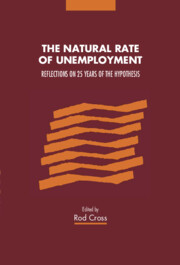Book contents
- Frontmatter
- Contents
- List of Contributors
- Preface
- 1 Introduction
- Part I The theoretical framework
- Part II Adjustment, ranges of equilibria and hysteresis
- Part III Empirical tests and macro models
- 11 The natural rate hypothesis and its testable implications
- 12 Non-linear dependence in unemployment, output and inflation: empirical evidence for the UK
- 13 Prices, wages and employment in the US economy: a traditional model and tests of some alternatives
- 14 The natural rate in empirical macroeconomic models
- Part IV Political economy
- Index
11 - The natural rate hypothesis and its testable implications
Published online by Cambridge University Press: 03 May 2011
- Frontmatter
- Contents
- List of Contributors
- Preface
- 1 Introduction
- Part I The theoretical framework
- Part II Adjustment, ranges of equilibria and hysteresis
- Part III Empirical tests and macro models
- 11 The natural rate hypothesis and its testable implications
- 12 Non-linear dependence in unemployment, output and inflation: empirical evidence for the UK
- 13 Prices, wages and employment in the US economy: a traditional model and tests of some alternatives
- 14 The natural rate in empirical macroeconomic models
- Part IV Political economy
- Index
Summary
Introduction
The natural rate hypothesis (NRH) was introduced by Phelps (1967) and by Milton Friedman in his 1967 Presidential Address to the American Economic Association (1968). Friedman's version of the hypothesis is based on the Wicksellian concept of the ‘natural’ rate, and broadly speaking postulates that it is impossible to permanently reduce (increase) the realised or the ‘market’ rate of unemployment below (or above) its ‘natural’ level. The natural rate of unemployment, which plays a central role in the formulation of the natural rate hypothesis, is denned by Friedman (1968, p. 8) to be
the level that would be ground out by the Walrasian system of general equilibrium equations, provided there is imbedded in them the actual structural characteristics of the labor and commodity markets, including market imperfections, stochastic variability in demands and supplies, the cost of gathering information about job vacancies and labor availabilities, the costs of mobility, and so on.
According to this definition the natural rate of unemployment is not a constant or an immutable rate, but is determined by a host of market and non-market factors. It is influenced by government policy towards legal minimum wage rates, costs of searching for new employments, labour mobility, technological innovations and many other factors that have direct bearings on the workings of the labour and capital markets. Friedman's primary reason for introducing this concept, as with Wicksell before him, was an attempt to ‘separate the real forces from the monetary forces’ that impinge on the market rate of unemployment.
- Type
- Chapter
- Information
- The Natural Rate of UnemploymentReflections on 25 Years of the Hypothesis, pp. 203 - 230Publisher: Cambridge University PressPrint publication year: 1995
- 2
- Cited by



